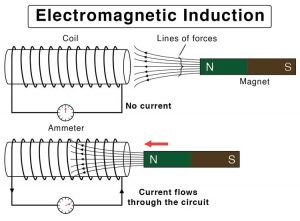What is Electromagnetic Induction? – Types, Applications, Principle
Basic Understanding of Electromagnetic Induction
Electromagnetic induction is a fascinating phenomenon that forms the basis for many electrical devices we use in our daily lives. By understanding the principles behind electromagnetic induction, we can appreciate its significance and applications.
What is Electromagnetic Induction?
Electromagnetic induction is when a changing magnetic field induces an electromotive force (EMF) or voltage in a conductor. This phenomenon was first discovered by the renowned physicist Michael Faraday in the 19th century.
Principle of Electromagnetic Induction
The principle of electromagnetic induction is governed by Faraday’s law, which states that the induced EMF is proportional to the rate of change of the magnetic flux through a closed loop. In simpler terms, it means that when the magnetic field around a conductor changes, a current is induced in the conductor.
Electromagnetic Induction Diagram
A typical diagram illustrating electromagnetic induction consists of a magnet moving toward a coil of wire. The changing magnetic field induces a current in the wire, as shown by the direction of the arrows in the diagram. This current can be used to power various electrical devices.

Explaining Electromagnetic Induction
Let’s break down the process of electromagnetic induction step by step. Imagine you have a coil of wire, also known as a solenoid, and you bring a magnet near it. As the magnet moves closer to the coil, the magnetic field passing through the coil increases. This increase in magnetic flux induces a current in the wire, generating electricity. Conversely, when the magnet moves away, the magnetic field weakens, causing a decrease in magnetic flux and inducing a current in the opposite direction. This process continues as long as there’s relative motion between the magnet and the coil or as long as there are changes in the magnetic field.
To better understand, let’s consider a real-life example. Think about how a bicycle dynamo works. When you pedal, the wheel’s rotation moves magnets past wire coils, inducing a current that powers the bike’s lights.
Types of Electromagnetic Induction
There are different types of electromagnetic induction, each with its unique characteristics:
- Self-Induction: This occurs when a changing current in a conductor induces an EMF in the same conductor.
- Mutual Induction: Mutual induction happens when the changing current in one conductor induces an EMF in another nearby conductor.
- Eddy Currents: Eddy currents are induced currents that circulate within a conductor due to changing magnetic fields.
What is Faraday’s Law of Electromagnetic Induction
Faraday’s Law states that the EMF induced in a closed loop is equal to the rate of change of magnetic flux through the loop. This law forms the foundation of electromagnetic induction and has various practical applications in electrical engineering.
To know more about Faraday’s Law, check our detailed explained article What are Faraday’s Laws of Electromagnetic Induction?
Application of Electromagnetic Induction
Electromagnetic induction has numerous practical applications:
- Electric Generators: They convert mechanical energy into electrical energy using the principle of electromagnetic induction.
- Transformers: These devices use mutual induction to change the voltage levels of alternating currents.
- Induction Cooktops: These use induction heating, a process based on electromagnetic induction, to heat pots and pans directly.
- Magnetic Resonance Imaging (MRI): This medical imaging technique relies on the principles of electromagnetic induction to generate detailed images of the body.
- Wireless Charging: Modern technology uses electromagnetic induction for wireless charging of devices like smartphones and electric vehicles.
Final Notes
Electromagnetic induction plays a crucial role in modern technology and is a fundamental concept in physics. We can appreciate its significance in shaping our world by understanding its principles and applications.
This article explores the concept of electromagnetic induction along with its circuit diagram and practical applications of electromagnetic induction. For further insights into related concepts, we encourage you to explore our blog section. If you’re seeking personalized online tuition services, Tutoroot offers exceptional physics online tuition. Our online sessions are designed to clarify any doubts you may have about various concepts. Click here to schedule a FREE DEMO session.
FAQs
State electromagnetic induction definition:
Electromagnetic induction is the process by which a changing magnetic field induces an electromotive force (EMF) in a conductor.
What is the principle of electromagnetic induction?:
The principle of electromagnetic induction is governed by Faraday’s law, stating that the induced EMF is proportional to the rate of change of magnetic flux through a closed loop.
Give 5 applications of electromagnetic induction:
- Generators
- Transformers
- Induction Cooktops
